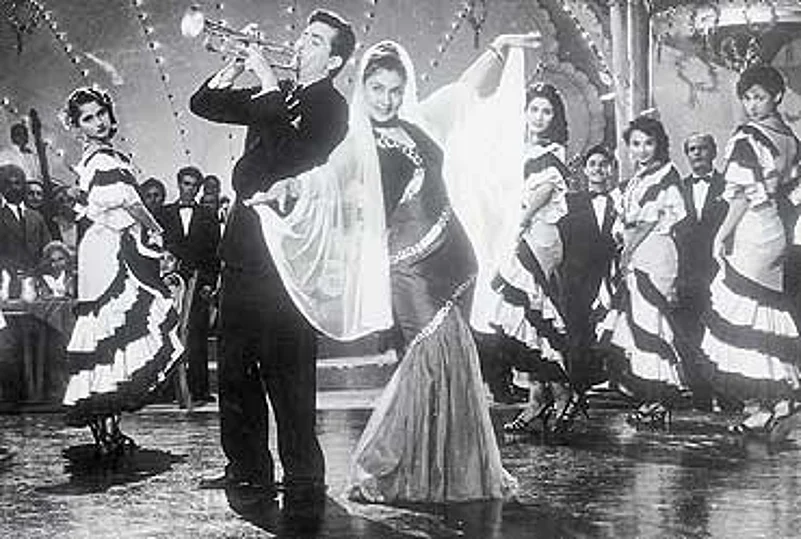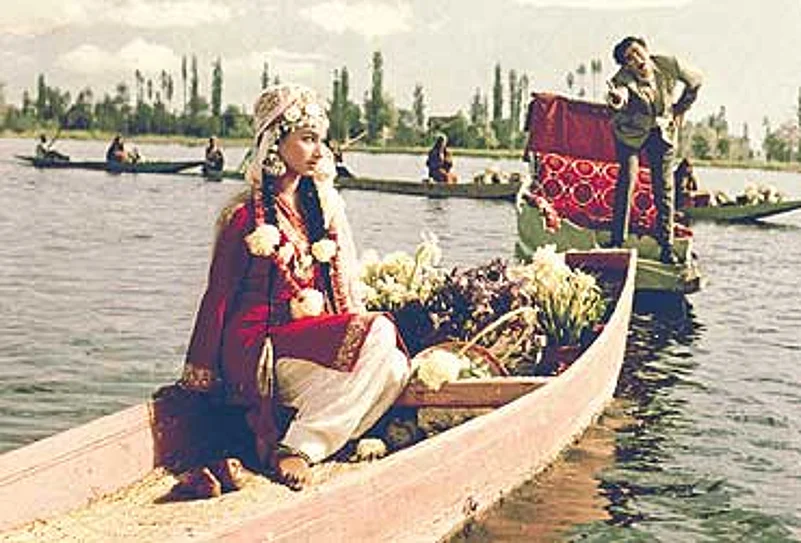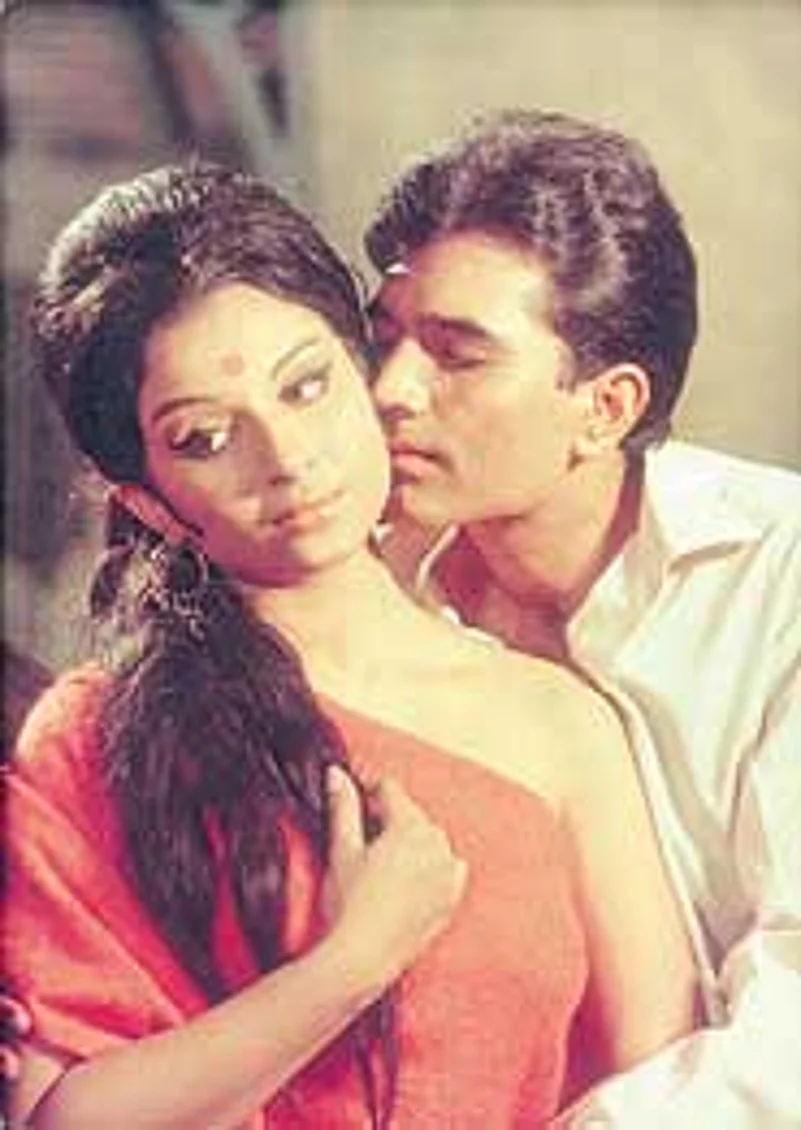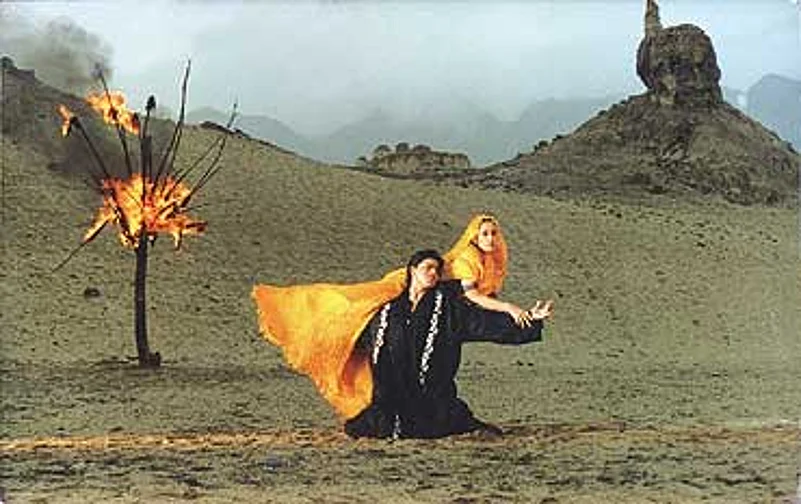
Mohammed Rafi, already well established as the music world's numero uno, was, interestingly, not a great RK favourite as his voice didn't match Raj Kapoor's. But Rafi's versatility was used by Shankar-Jaikishen to great effect for Raj's brother Shammi in signature films like Junglee (the flamboyant Chahe koyi mujhe junglee kahe and the soulful Ehsaan tera hoga mujh par) and An Evening in Paris (Aasmaan se aaya farishta and Akele akele kahan jaa rahe ho). Later, numbers from Tumse Achchha Kaun Hai and Brahmachari (Aaj-kal tere mere pyar ke charche, Dil ke jharokhe mein) went on to become chartbusters as big as Raj Kapoor's Jis Desh Mein Ganga Behti Hai, Sangam and Mera Naam Joker.
Shankar-Jaikishen were the pioneers of Hindi cinema's musical makeover. They set an example before countless aspiring composers that you had to dare to win. They proved that India's first post-Independence generation was waiting to break free of traditional, strictly classical-based compositions. But they were equally steeped in the classical tradition, if you consider numbers such as Sur na saje kya gaaoon main (Basant Bahar), Tu pyar ka sagar hai (Seema) from the '50s to Rimjhim sajan, barse nayan (Gaban) and Re man sur mein gaa (Lal Patthar) in the early '70s. Shankar-Jaikishen's avant-garde music, initially patronised by Raj Kapoor and then by the entire film industry, led to a sharp division of genres, between the purists and the experimentalists. In the first category were composers like Naushad, Roshan and Madan Mohan, while C. Ramachandra and O.P. Nayyar led the "brat pack".
Naushad, with superhits like Baiju Bawra under his belt, emerged as the first choice of Raj Kapoor's ratings rival, Dilip Kumar. He gave some great music for Dilip Kumar's films such as Ganga-Jamuna, Dil Diya Dard Liya, Ram Aur Shyam, Sunghursh and Aadmi. In between came Mughal-e-Azam and Mother India, two films that set real benchmarks for the Bombay film industry. Naushad's music, especially for Mughal-e-Azam, blazed a trail, as did some of his later compositions for films like Kohinoor (Madhuban mein Radhika nache re). But being a one-film-at-a-time music director, he was never quite a part of the market share race.
Naushad's contemporary, Roshan, was not exactly in the same mould. In fact, he was quite an experimentalist, although his experiments did not break the parameters of classicism. His successful use of the qawwali spawned many imitations but none quite as memorable as his Na toh karvan ki talaash hai (Barsaat ki Raat). With Bheegi Raat (Dil jo na keh sakaa), Dil Hi To Hai (Laaga chunri mein daag) and Aarti (Ab kya misaal doon main tumhare shabaab ki), Roshan reached a new high. Then came Mamta with numbers like Rahen na rahen hum and Chhupa lo yun dil mein pyar mera, probably the high watermark of his career.
Compared to Naushad and Roshan, Madan Mohan was a later entry and not quite a hardline puritan, evident from compositions like Zaroorat hai zaroorat hai or Maine rakkha hai mohabbat. Madan Mohan's finest hour was probably Chetan Anand's Haqeeqat, based on India's tragic defeat in the 1962 war with China. Kar chale hum fida jaan-o-tan sathiyon still brings tears to people's eyes and was put to devastating electoral effect by the Congress following Rajiv Gandhi's 1991 assassination.
Among the experimentalists, C. Ramachandra should take pride of place for his immortal hip-swingers like Shaam dhale khidki taley and, of course, Aana meri jaan, meri jaan, Sunday ke Sunday. Ramchandra was a talented classical composer too; Lata Mangeshkar rendered some of her best for his Anarkali (Yeh zindagi usiki hai).

But no one had a bigger impact on film music's evolution in the '60s than Omkar Prakash Nayyar, who meandered his way into Mumbai, and with some difficulty. But after CID (Yeh hai Bombay meri jaan and Ishaaron ishaaron mein), he never looked back and progressively attained a creative peak that gave jitters to the reigning overlords, Shankar-Jaikishen. O.P. Nayyar combined melody with beat and that gave him a phenomenal edge over his competitors. Although his tunes had a strong classical content, the beats were incredibly catchy, like the songs from his first mega hit, Kashmir ki Kali. If Deewana hua badal had a soulful lilt, Tareef karoon kya uski led people to break into a jig inside movie halls. O.P. Nayyar gave some superb music for Joy Mukherjee starrers like Phir Wohi Dil Laya Hoon and Ek Musafir Ek Hasina (Aap yunhi agar). For the Dharmendra-Tanuja starrer Baharen Phir Bhi Aayengi, he composed Tu mere saamne hai teri zulfein hain khuli, a Rafi classic. His music for Tumsa Nahi Dekha with its infectious hoof-beat background, Saawan ki Ghata (Haule haule chalo mere saajna) and Mere Sanam was equally memorable. The temperamental music director, however, failed to hold on to most banners and even singers. But it was his creative genius, laced with a stormy romance, that transformed Asha Bhonsle from a fledgling shadow of elder sister Lata to India's most engaging and long-lasting voice. O.P. Nayyar ended his career with relatively small-time films like Yeh Raat Phir Na Aayegi (Yehi woh jagaah hai), Kismat and Pran Jaye Par Vachan Na Jaye. For Kismat, he was forced to use Mahendra Kapoor, as even the usually affable Rafi was no longer willing to sing for him. Still, he produced superhits like Laakhon hain yahan dilwale and the sensuous Asha number Aao huzoor tumko... Irony piled upon irony by the time Pran Jaye... was released. Chain se humko kabhi, perhaps O.P. Nayyar's most melodious composition, rendered by Asha with abundant pathos, got the singer her first Filmfare award. But Asha had broken up with him just then and since the lyrics could well be related to their relationship, she refused to attend the function to collect the trophy.
The narrative of the '60s would be incomplete without reference to the extraordinarily talented Salil Choudhury who hit big time with Bimal Roy's Madhumati. Blending Bengali folk, German Weimar music and Mozart (Itna na mujhse tu pyar badha) with hill tunes, Salil Choudhury was a rare original composer who carved a niche for himself without entering the rat race, as his numbers for Anand testify.
In the also-ran category of the time were music directors like Jaidev (Hum Dono and later Reshma aur Shera) and Khayyam (Phir Subah Hogi, Shola aur Shabnam, and later Kabhi-Kabhie). Some of the other "lesser" composers like Ravi were lucky to have a godfather in B.R. Chopra. Starting with Dharamputra, Ravi gave music for almost all B.R. Films offerings including the classic Waqt, Gumraah, Humraaz and Nikaah. B.R. Chopra, his brother Yash (till they broke ranks with Daag), lyricist Sahir Ludhianvi, music director Ravi and singer Mahendra Kapoor made a close-knit Punjab club that contributed immeasurably to upgrading the quality of music in Hindi cinema.
An even more talented composer was Hemant Kumar. Breaking into the world of Hindi music from his native Bengal, Hemant made everybody sit up with Nagin (Man dole mera tan dole). His Bees Saal Baad (Zara nazron se kehdo ji and Beqarar karke humen) took India by storm. Hemant was as good a singer as he was a composer and a succession of music directors, particularly S.D. Burman, used him to great effect. His compositions for Khamoshi (Tum pukar lo and Humne dekhi hai) continue to figure on Vividh Bharati and can be heard across middle India more than 35 years after they were made.
The '60s were probably Hindi film music's finest decade. Even as Shankar-Jaikishen ruled, challengers had begun to dent their supremacy. The one who outlasted all others was S.D. Burman with son Rahul Dev in tow. Meanwhile, Kalyanji-Anandji emerged as the poor man's Shankar-Jaikishen after they composed music for Raj Kapoor's Chhalia (Dum-dum diga diga). Kalyanji-Anandji blended folk, classical and Western in catchy ways to produce vigorous, earthy numbers, especially for Manoj Kumar's films. Mere desh ki dharti remains a perennial favourite on national occasions, along with Hai preet jahan ki reet sada (Purab Aur Paschim). They also gave some memorable music for Saraswatichandra (Chandan sa badan), Safar (Jeevan se bhari teri aankhen) and Blackmail (Pal pal dil ke paas). In the early '80s, in association with London-based musician Biddu, they composed Aap jaisa koyi for Qurbani, marking Nazia Hasan's grand entry to the world of Hindi music and India's initiation into the genre of Indipop.
If Barsaat and Awara marked the First Revolution in Hindi music, the second happened in the early '60s, just about 10 years later. In 1963, two new music directors made their entry without too much fanfare. That year, the exceptionally talented R.D. Burman independently composed music for Chhote Nawab (Chandan ka palna). Simultaneously, Laxmikant-Pyarelal, Bombay music's most enduring duo, emerged as music directors on their own steam (they were Kalyanji-Anandji's assistants in Chhalia) with a B-grade mythological, Parasmani, whose numbers such as Woh jab yaad aaye continue to haunt music lovers.

R. D. Burman drew heavily from the legacy of his father, who was probably filmdom's most discerning and creative composer. Highly selective about assignments, S.D. Burman composed mainly for Navketan Films and, thus, his music came to be closely associated with Dev Anand, the third angle of the evergreen hero triangle, the other two being Raj Kapoor and Dilip Kumar. S.D. gave incredible music for a succession of Dev Anand starrers like Baazi, Taxi Driver, Tere Ghar ke Saamne, Bambai ka Babu, Kala Pani, Kala Bazar, the immortal Guide, Jewel Thief, Prem Pujari, Tere Mere Sapne and countless others. S.D. composed memorable numbers for Bandini and Sujata. Besides, he gave music for a host of Guru Dutt's films such as Pyaasa and Kaagaz ke Phool (Bichhde sabhi baari baari and Waqt ne kiya). S.D. Burman was also responsible for creating magical music for Rajesh Khanna's launch vehicle Aradhana. Its songs like Mere sapnon ki rani and Roop tera mastana helped catapult the young hero to India's first superstar status and also revived the sagging career of his favourite playback singer, Kishore Kumar. In fact, Kishore was also a composer in his own right. His music from Jhumroo (Thandi hawa ye chandni suhani), Door Gagan ki Chhaon mein (Aa chal ke tujhe) and Door ka Raahi (Beqarar dil) testify to the incredible talent of a man who had no formal training in music.
R.D. Burman evolved as music maker under his father's tutelage, helping compose whenever S.D. was unwell, like during the making of Jewel Thief and Aradhana. R.D. caught the film world's eye by giving some really breezy music in Teesri Manzil. Its songs like O haseena zulfon wali, Aaja aaja, O mere Sona re, enthralled music lovers despite their strong Shankar-Jaikishen, rather than S.D. Burman, lineage. Thereafter, R.D. kept busting the charts with catchy numbers like Mere saamnewali khidki mein (Padosan), a host of foot-tappers in Yaadon ki Baraat and a succession of films for the Nasir Husain banner like Hum Kisise Kum Nahi and Zamane ko Dikhana Hai.
Obsessed with creativity, R.D. was said to eat, drink, breathe, think music 24/7. Asha Bhonsle, whom he not only recreated after her tragic break with O.P. Nayyar, but also eventually married, has recalled in interviews that she would wake up at 4 am to find him sitting in front of a record player listening to the latest western compositions. R.D. Burman was a radical, an iconoclast who brought a gale of fresh air to Hindi film music. He had a fun streak in him, apparent from compositions like Aao twist karein (Bhoot Bangla), Dekha na haye re (Bombay to Goa) and Apna Desh's Duniya mein logon ko, interspersed with his trademark guttural sounds.
Despite being contemporaries and competitors for the top slot, R.D. Burman and Laxmikant-Pyarelal were the best of friends. Being more prolific and perhaps more consistent, L-P with their typical folksy tunes to the accompaniment of the dholak captured the imagination of middle India more effectively. L-P's style was lapped up by "Bharat" while "India" swung to R.D.'s melodies. The sophisticated urbanite turned up his nose at Sawan ka mahina (Milan) or Bindiya chamkegi (Do Raaste), but both went on to become all-time hits. L-P had a big hand in restoring folk into the mainstream of film music, whether it was with all numbers of Aaye Din Bahar Ke, Aaya Sawan Jhoom Ke, Aan Milo Sajna, Jeene ki Raah and Sargam right to their final Koliwada-style hits like Ek do teen (Tezaab) and Choli ke peechhe kya hai (Khalnayak). In that sense, they broke the spell of cacophonous western instrumentation that had unfortunately crept into Shankar-Jaikishen's music in the '70s.
L-P, supremely melodious in their compositions, had a certain softness that distinguished their numbers from the rest—for example, even a rare Lata cabaret like Aa jaane-jaan (Inteqam), Yeh dil tum bin (Izzat), Roz shaam aati thi (Imtihan) or Ek pyar ka nagma hai (Shor) had a lilting quality. They broke into big banner after big banner despite starting with Sheikh Mukhtar and Dara Singh C-graders like Ustadon ke Ustad or a Kishore-starring potboiler Mr X in Bombay (Mere mehboob qayamat hogi). Their crowning glory came in 1973 with R.K. Films' Bobby, when Raj Kapoor finally broke with Shankar-Jaikishen. Rajesh Khanna may have begun with S.D. Burman and his son, but progressively his films moved into the L-P camp with Dushman, Daag and Hathi Mere Sathi. While songs of their earliest big banner assignment, Dosti (Chahunga main tujhe.), and even mythologicals like Sati Savitri (Tum gagan ke chandrama ho) are hummed to date, they eased themselves out of the scene in a blaze of hits that included Jumma chumma (Hum). They also composed superhits for most of Subhash Ghai's films, with Karz's Om Shanti Om ranking among the most popular songs of the '80s. Great favourites of Manmohan Desai, for whom they composed such classics as My name is Anthony Gonsalves (Amar, Akbar, Anthony), L-P ruled Bombay's world of music as no one had done before and no one will probably do again.

Since the '90s, popular music has gradually shifted out of the sole orbit of cinema and now revolves in several trajectories such as remixes, bhangra-pop, Indipop and also ghazals, though the high noon of the last genre has now waned. An array of talented composers like Nadeem Shravan, Anu Malik, Anand-Milind, Anand Raaj Anand, Ismail Darbar, Himesh Reshammiya and Shantanu Moitra keep enthralling India with their creativity. Popular music is still dominated by Hindi cinema and composers like A.R. Rahman continue to produce timeless melody. Rahman took India by storm with Roja and thereafter most of his films such as Bombay, Dil Se, Sapnay, Taal, and even the obscure Deepa Mehta movie 1947: Earth, have deeply impacted the music world. His masterly control over electronic instrumentation led him to be invited to stage a concert at Albert Hall and compose music for Bombay Dreams. His interpretations of Vande Mataram (Maa tujhe salaam) for the 50th anniversary of Independence may have got the goat of purists, but GenNext loved them.
Rahman and his compatriots have demonstrated that India is now ready to break the set moulds of popular music. They have also given us confidence in India's innate talent to produce cross-country melody: music from the south is today as popular in the north as bhangra is in the discos of Bangalore.
















